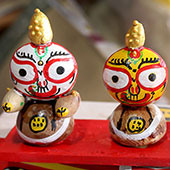Design Resource
Betel Nut Carvings - Bhubaneswar, Orissa
Handcrafted Objects
by
Prof. Bibhudutta Baral and Hariharasudan T.
The areca nut is the seed of the areca palm (Areca catechu), which grows in much of the tropical Pacific, Southeast and South Asia, and parts of east Africa. India is the largest producer of areca nut and at the same time largest consumer also. Major states cultivating this crop are Karnataka, Kerala, Assam, Tamil Nadu, Meghalaya and West Bengal. This seed is commonly used along with betel leaves, so it is easily confused with betel nut.
Betel nut originated in the Philippines or Malaysia, but it owes its Latin name, “Areca cachu,” to the Indian coast. The areca nut is not a true nut, but rather a fruit categorized as a berry. The areca palm fruit isn’t prized as much as the nut. It is commercially available in dried, cured and fresh forms.
The nut inside is soft enough to be cut with a typical knife when the husk of the fresh fruit is green. As the fruit ripens, the husk becomes yellow or orange, as it dries, the fruit inside hardens to a wood-like texture. At this stage, the nut can only be sliced using a cutter, which looks similar to scissors.
Areca nut is capable of growing in a variety of soils. It requires abundant and well-distributed rainfall. It grows well within the temperature range of 14˚-36˚C. Areca nut can be grown in areas receiving annual rainfall of 750 mm to 4,500 mm. It can be cultivated up to an altitude of 1000 m in deep and well-drained soils with a low water table. Laterite, red loam and alluvial soils are most suited.
Chewing the mixture of areca nut and betel leaf is a tradition, custom or ritual which dates back thousands of years. It is not known how or when the areca nut and the betel leaf were first combined into one psychoactive drug. Archaeological evidence from Thailand, Indonesia and the Philippines suggest they have been used in tandem for at least 4000 years. In the Indian subcontinent, the chewing of betel and areca nuts dates back to the pre-Vedic period Harappan Empire.
Regular eating of areca nut has adverse side effects. Regular chewing of betel nut can also cause gum irritation and tooth decay. Habitual chewers of betel leaf and areca nut have a greatly increased risk of developing a range of serious diseases, including cancers of the mouth and esophagus.
Apart from using areca nut for consumption, it is also used in making handcrafted objects.






